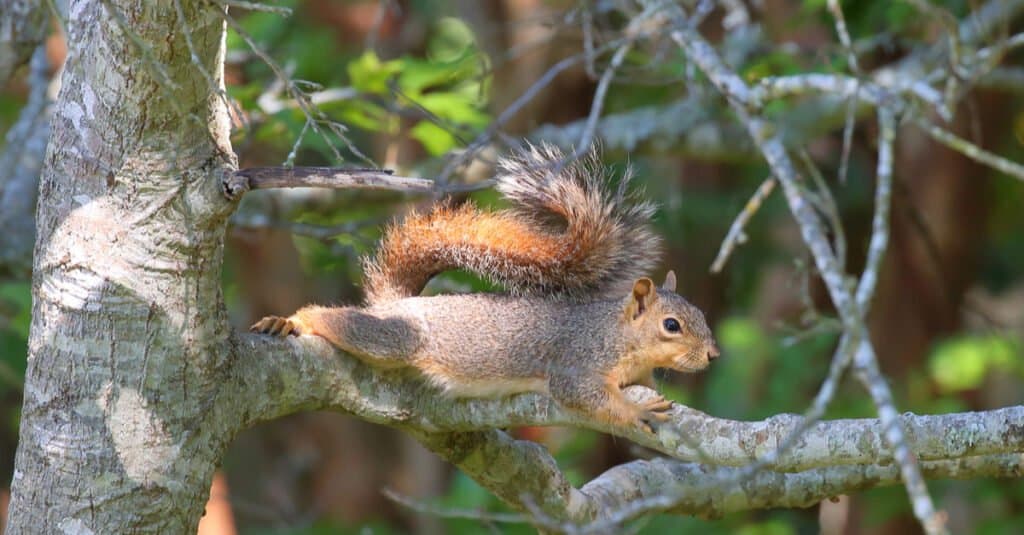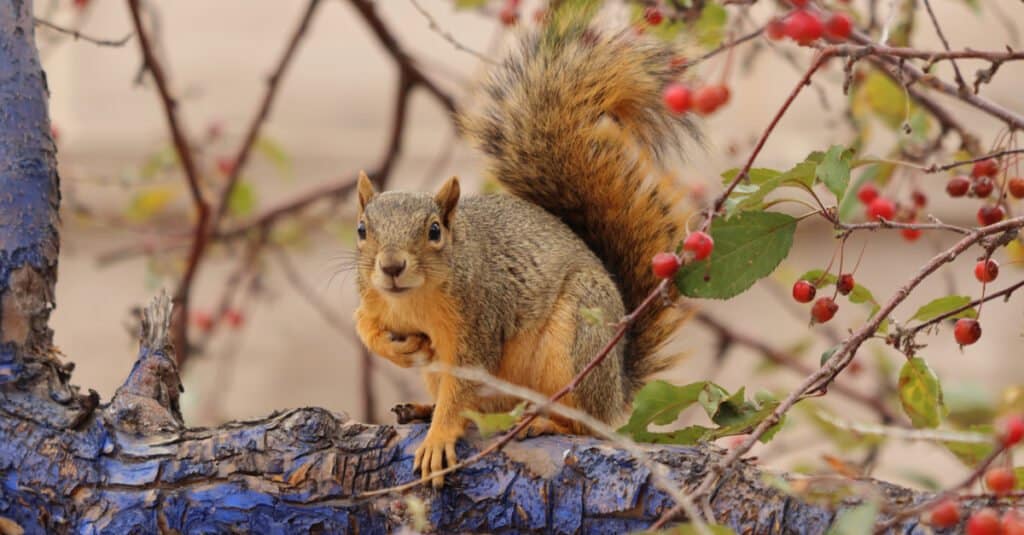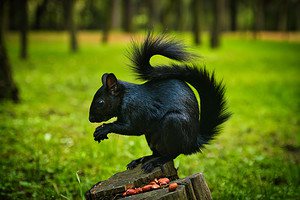The fox squirrel and the American red squirrel are extremely similar creatures with overlapping ranges. As such, these squirrels are often mistaken for one another. Telling them apart can be tough, but thankfully, they have some distinct differences. Let’s compare the Fox Squirrel vs Red Squirrel to see what makes them unique!
Comparing a Fox Squirrel and a Red Squirrel

| Fox Squirrel | Red Squirrel | |
|---|---|---|
| Size | Largest of all American tree squirrels. Usually, 20-30 inches long. | Smaller than most North American squirrels. Usually 10-15 inches long and are slightly larger than a chipmunk. |
| Appearance | Three colorations across regions: brown-grey to brown-yellow is most common, Appalachians have dark brown and black colors with white stripes, and southern squirrels are uniformly black. | Rusty red with a white underbelly. |
| Distribution | Eastern United States into Canada. As far west as Kansas and the Great Plains. | Canada, Alaska, the Rocky Mountains, and the Northeastern United States. |
| Habitat | Open forest with little understory brush or undergrowth. | Year-round territory of conifer forests, but has recently been expanding into hardwoods. |
| Diet | Location dependent. Mostly tree buds, insects, tuners, bulbs, and seeds. | Granivores, but specialize in conifer seeds. Common foods include spruce seeds, mushrooms, berries, and even bird eggs. |
The 5 Main Differences Between a Fox Squirrel and a Red Squirrel
The main differences between fox squirrels and red squirrels are their size, coloration, and distribution.
Fox squirrels and American red squirrels are relatively common across the United States. Although they aren’t as common as the gray squirrel, they have a similar range and appearance. These arboreal squirrels are often confused with one another.
The fox squirrel is generally recognized as the largest arboreal squirrel in the United States. They can reach lengths of 30 inches (including the tail), far larger than their cousin, the red squirrel. American red squirrels (not to be confused with European red squirrels) are larger than a chipmunk but are quite small compared to the much larger fox squirrel. They usually only reach 10-15 inches long.
Aside from size, the fox squirrel and red squirrel have extremely similar proportions. Both have fluffy fur, bushy tails, and the overall characteristics that one would expect from a squirrel. Importantly, fox squirrels are not flying squirrels as many people think of them. Although similar in proportions and body shape, both squirrels come in different colors, especially according to the regions they can be located.
Let’s explore these differences, plus a few more, in detail below.
Fox Squirrel vs Red Squirrel: Size

The tail of a fox squirrel measures almost as long as its body.
©JustPixs/Shutterstock.com
The fox squirrel is usually recognized as the largest tree squirrel in North America. On average, they can measure 20-30 inches long, including the tail. Incredibly, they can even weigh up to 2.5 lbs in certain places, although western squirrels are normally smaller.
The American red squirrel is on the smaller side of the tree squirrels in North America. Generally, they measure 10-15 inches long, including the tail, and they are a little larger than the average chipmunk.
Fox Squirrel vs Red Squirrel: Appearance

Red squirrels (Sciurus vulgaris) are known for their striking orange-red fur.
©seawhisper/Shutterstock.com
The fox squirrel is quite variable in appearance, especially moving from region to region. There are 10 distinct subspecies, each with a slightly different appearance. The most common coloration for a fox squirrel is grey-brown or yellow-brown with a reddish-orange tail and a brownish-orange belly. In the Appalachians, they are known to be dark brown and black with white bands on their heads and tails. In the south, they are known to be uniformly black.
The American red squirrel is a rusty-grey color with white bellies. Their tails are darker red and are often ringed in a dark black, giving them a “fiery” appearance.
Fox Squirrel vs Red Squirrel: Distribution

Fox squirrels are found across most of the United States and central Canada.
©Nico Giuliani/Shutterstock.com
The fox squirrel is extremely widespread. They can be found through most of the eastern United States, into the prairie regions of central Canada, west into Colorado and Texas, and have been introduced along the west coast, albeit unnaturally.
American red squirrels have a more northerly range than the fox squirrel. They are generally found in Canada, Alaska, the Rocky Mountains, and the Northeastern United States. Their most southerly range is in northern Arizona at the terminus of the Rocky Mountains.
Fox Squirrel vs Red Squirrel: Habitat

Since they mostly eat pine nuts, red squirrels are found in coniferous forest stands.
©Giedriius/Shutterstock.com
Fox squirrels are pretty variable in their habitat, but they have a preference. They almost always prefer large forest stands with little understory growth and floor vegetation.
Red squirrels have a habitat that reflects their diets. Since they mostly eat pine nuts, they are found in coniferous forest stands. They have been recently expanding into hardwood forests and showing new, adaptive behaviors.
Fox Squirrel vs Red Squirrel: Diet

Fox squirrels eat nuts, fruits, berries, fungus, and more.
©Vaclav Matous/Shutterstock.com
The fox squirrel is a variable eater with a diet similar to the grey squirrel. Additionally, their diets change with the region in which they live. Still, they mostly prefer tree buds, insects, tuners, bulbs, and seeds.
Red squirrels are more selective in their diets. They generally prefer conifer seeds, with white spruce seeds making up 50% of a red squirrel’s diet in many populations. Additionally, they eat other seeds, buds, mushrooms, and berries.
The photo featured at the top of this post is © Menno Schaefer/Shutterstock.com
Thank you for reading! Have some feedback for us? Contact the AZ Animals editorial team.







